小学英语阅读解题技巧 1 (附阅读材料)
- 格式:doc
- 大小:59.00 KB
- 文档页数:2
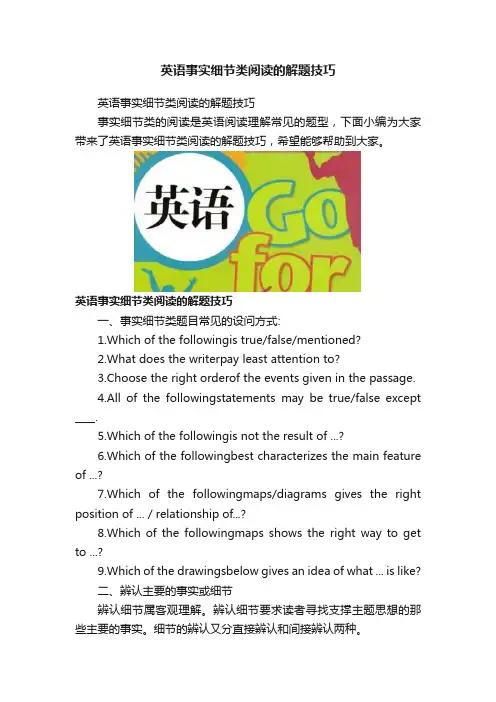
英语事实细节类阅读的解题技巧英语事实细节类阅读的解题技巧事实细节类的阅读是英语阅读理解常见的题型,下面小编为大家带来了英语事实细节类阅读的解题技巧,希望能够帮助到大家。
英语事实细节类阅读的解题技巧一、事实细节类题目常见的设问方式:1.Which of the followingis true/false/mentioned?2.What does the writerpay least attention to?3.Choose the right orderof the events given in the passage.4.All of the followingstatements may be true/false except ____.5.Which of the followingis not the result of ...?6.Which of the followingbest characterizes the main feature of ...?7.Which of the followingmaps/diagrams gives the right position of ... / relationship of...?8.Which of the followingmaps shows the right way to get to ...?9.Which of the drawingsbelow gives an idea of what ... is like?二、辨认主要的事实或细节辨认细节属客观理解。
辨认细节要求读者寻找支撑主题思想的那些主要的事实。
细节的辨认又分直接辨认和间接辨认两种。
1.直接辨认细节的直接辨认不要求读者对客观的事实作解释或判断,只要求他们从阅读材料中直接获取信息。
同时还要求读者记住重要的细节,在必要的时候(作判断、推论或结论的时候)能准确而迅速地将它们回忆出来。
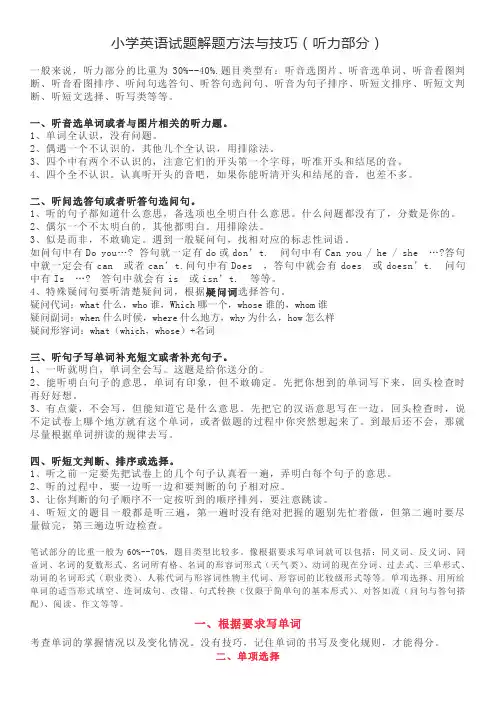
小学英语试题解题方法与技巧(听力部分)一般来说,听力部分的比重为30%--40%.题目类型有:听音选图片、听音选单词、听音看图判断、听音看图排序、听问句选答句、听答句选问句、听音为句子排序、听短文排序、听短文判断、听短文选择、听写类等等。
一、听音选单词或者与图片相关的听力题。
1、单词全认识,没有问题。
2、偶遇一个不认识的,其他几个全认识,用排除法。
3、四个中有两个不认识的,注意它们的开头第一个字母,听准开头和结尾的音。
4、四个全不认识。
认真听开头的音吧,如果你能听清开头和结尾的音,也差不多。
二、听问选答句或者听答句选问句。
1、听的句子都知道什么意思,备选项也全明白什么意思。
什么问题都没有了,分数是你的。
2、偶尔一个不太明白的,其他都明白。
用排除法。
3、似是而非,不敢确定。
遇到一般疑问句,找相对应的标志性词语。
如问句中有Do you…? 答句就一定有do或don’t. 问句中有Can you / he / she …?答句中就一定会有can 或者can’t.问句中有Does ,答句中就会有does 或doesn’t. 问句中有Is …? 答句中就会有is 或isn’t. 等等。
4、特殊疑问句要听清楚疑问词,根据疑问词选择答句。
疑问代词:what什么,who谁,Which哪一个,whose谁的,whom谁疑问副词:when什么时候,where什么地方,why为什么,how怎么样疑问形容词:what(which,whose)+名词三、听句子写单词补充短文或者补充句子。
1、一听就明白,单词全会写。
这题是给你送分的。
2、能听明白句子的意思,单词有印象,但不敢确定。
先把你想到的单词写下来,回头检查时再好好想。
3、有点蒙,不会写,但能知道它是什么意思。
先把它的汉语意思写在一边。
回头检查时,说不定试卷上哪个地方就有这个单词,或者做题的过程中你突然想起来了。
到最后还不会,那就尽量根据单词拼读的规律去写。
四、听短文判断、排序或选择。
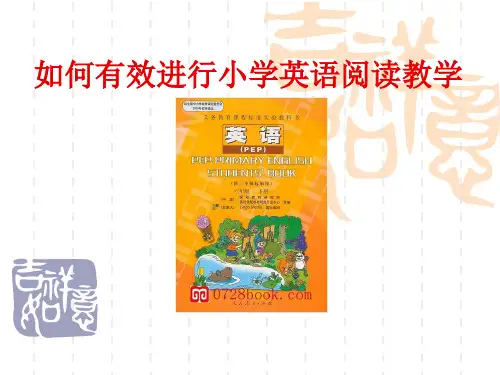
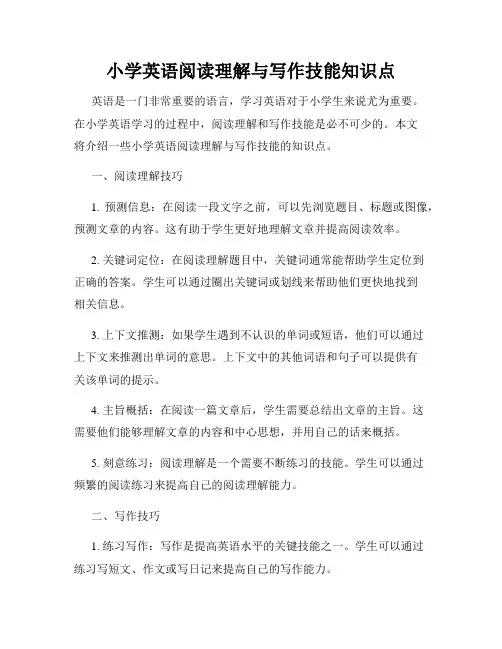
小学英语阅读理解与写作技能知识点英语是一门非常重要的语言,学习英语对于小学生来说尤为重要。
在小学英语学习的过程中,阅读理解和写作技能是必不可少的。
本文将介绍一些小学英语阅读理解与写作技能的知识点。
一、阅读理解技巧1. 预测信息:在阅读一段文字之前,可以先浏览题目、标题或图像,预测文章的内容。
这有助于学生更好地理解文章并提高阅读效率。
2. 关键词定位:在阅读理解题目中,关键词通常能帮助学生定位到正确的答案。
学生可以通过圈出关键词或划线来帮助他们更快地找到相关信息。
3. 上下文推测:如果学生遇到不认识的单词或短语,他们可以通过上下文来推测出单词的意思。
上下文中的其他词语和句子可以提供有关该单词的提示。
4. 主旨概括:在阅读一篇文章后,学生需要总结出文章的主旨。
这需要他们能够理解文章的内容和中心思想,并用自己的话来概括。
5. 刻意练习:阅读理解是一个需要不断练习的技能。
学生可以通过频繁的阅读练习来提高自己的阅读理解能力。
二、写作技巧1. 练习写作:写作是提高英语水平的关键技能之一。
学生可以通过练习写短文、作文或写日记来提高自己的写作能力。
2. 增加词汇量:丰富的词汇量对于写作是非常重要的。
学生可以通过阅读英语故事书、课外书籍或使用词汇卡来增加自己的词汇量。
3. 使用语法正确:正确的语法是书写流畅和准确沟通的关键。
学生需要学习和掌握一些基本的语法规则,如时态、句子结构等。
4. 好的开头和结尾:写作的开头和结尾是给读者的第一印象和最后印象。
学生可以使用一些有趣的开头和恰当的结尾来吸引读者的注意力。
5. 修订和编辑:写作并不只是一遍就可以完成的。
学生需要经常修订和编辑他们的作品,确保句子通顺、语法正确、表达准确。
小学英语阅读理解与写作技能知识点至此介绍完毕。
希望这些技巧能对小学生们提高英语阅读理解和写作能力有所帮助。
通过不断的练习和努力,他们一定能够在英语学习中取得更大的进步。
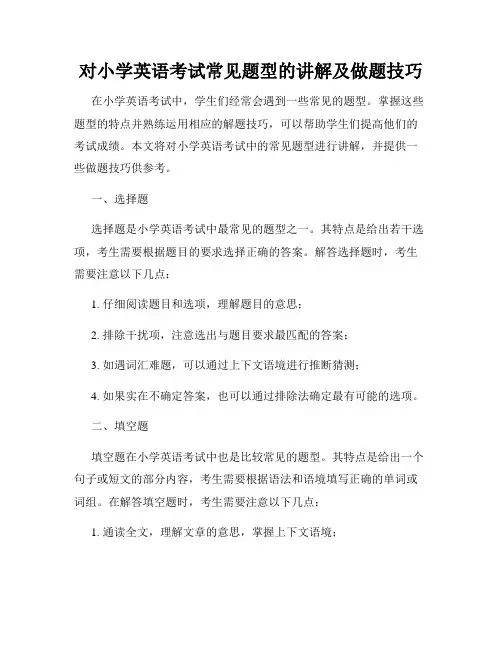
对小学英语考试常见题型的讲解及做题技巧在小学英语考试中,学生们经常会遇到一些常见的题型。
掌握这些题型的特点并熟练运用相应的解题技巧,可以帮助学生们提高他们的考试成绩。
本文将对小学英语考试中的常见题型进行讲解,并提供一些做题技巧供参考。
一、选择题选择题是小学英语考试中最常见的题型之一。
其特点是给出若干选项,考生需要根据题目的要求选择正确的答案。
解答选择题时,考生需要注意以下几点:1. 仔细阅读题目和选项,理解题目的意思;2. 排除干扰项,注意选出与题目要求最匹配的答案;3. 如遇词汇难题,可以通过上下文语境进行推断猜测;4. 如果实在不确定答案,也可以通过排除法确定最有可能的选项。
二、填空题填空题在小学英语考试中也是比较常见的题型。
其特点是给出一个句子或短文的部分内容,考生需要根据语法和语境填写正确的单词或词组。
在解答填空题时,考生需要注意以下几点:1. 通读全文,理解文章的意思,掌握上下文语境;2. 根据文章的意思,选择合适的词语填写,注意语法和时态的正确性;3. 注意句子之间的连贯性,确保填写的内容与上下文相呼应。
三、阅读理解题阅读理解题在小学英语考试中一般分为短文题和问答题两种形式。
考生需要根据给出的短文或问题选择正确的答案。
在解答阅读理解题时,考生需要注意以下几点:1. 仔细阅读短文或问题,理解文章的大意和问题的要求;2. 注意关键词,通过定位词等线索找到相关信息;3. 注意文章的结构和逻辑,理解文章的主旨和细节;4. 阅读选项时,要与文章进行对比,选择最符合文章意思的选项。
四、补全对话题补全对话题是小学英语考试中的一种常见题型,要求考生根据对话的上下文,选择适当的句子来补全对话。
在解答补全对话题时,考生需要注意以下几点:1. 通读对话,理解对话的背景和情景;2. 注意语境,选择与对话情景相匹配的句子;3. 注意对话的逻辑和连贯性,选择能够与对话前后内容衔接自然的句子。
五、连词成句题连词成句题是小学英语考试中的一种常见题型,考生需要根据给出的一组词语,按照语法规则和句子结构规范组成一个完整的句子。
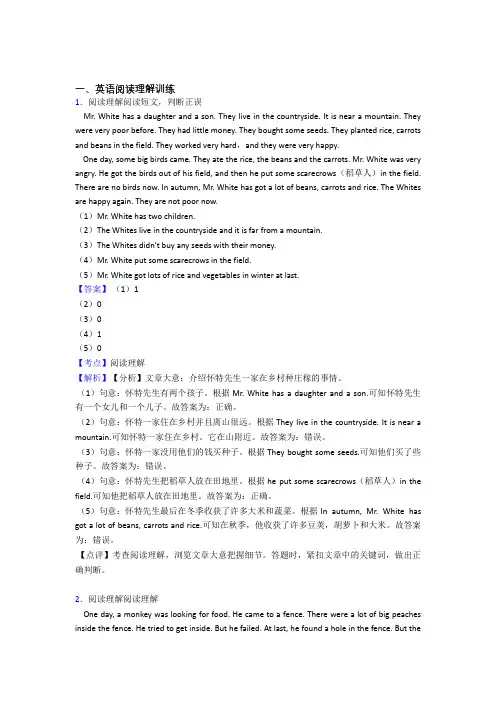
一、英语阅读理解训练1.阅读理解阅读短文,判断正误Mr. White has a daughter and a son. They live in the countryside. It is near a mountain. They were very poor before. They had little money. They bought some seeds. They planted rice, carrots and beans in the field. They worked very hard,and they were very happy.One day, some big birds came. They ate the rice, the beans and the carrots. Mr. White was very angry. He got the birds out of his field, and then he put some scarecrows(稻草人)in the field. There are no birds now. In autumn, Mr. White has got a lot of beans, carrots and rice. The Whites are happy again. They are not poor now.(1)Mr. White has two children.(2)The Whites live in the countryside and it is far from a mountain.(3)The Whites didn't buy any seeds with their money.(4)Mr. White put some scarecrows in the field.(5)Mr. White got lots of rice and vegetables in winter at last.【答案】(1)1(2)0(3)0(4)1(5)0【考点】阅读理解【解析】【分析】文章大意:介绍怀特先生一家在乡村种庄稼的事情。
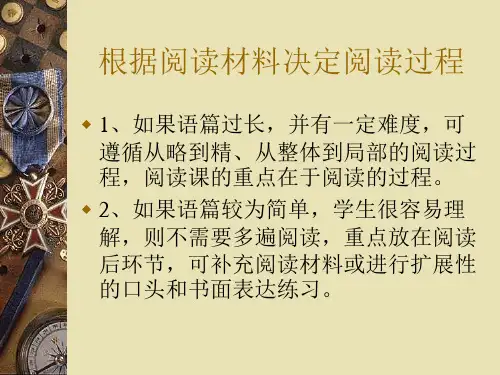
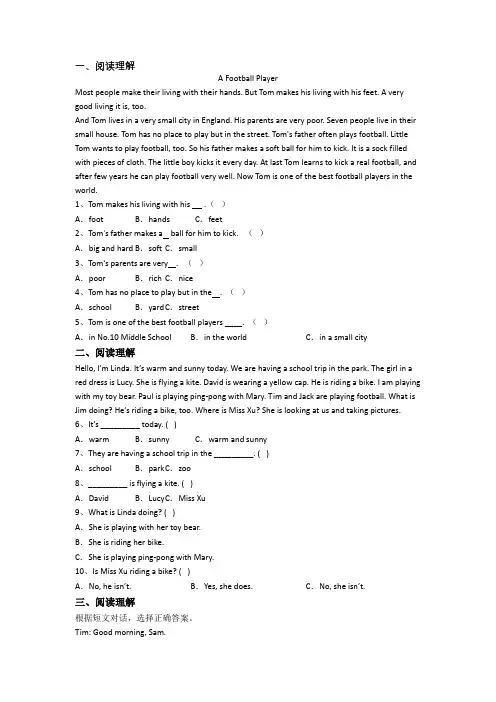
一、阅读理解A Football PlayerMost people make their living with their hands. But Tom makes his living with his feet. A very good living it is, too.And Tom lives in a very small city in England. His parents are very poor. Seven people live in their small house. Tom has no place to play but in the street. Tom's father often plays football. Little Tom wants to play football, too. So his father makes a soft ball for him to kick. It is a sock filled with pieces of cloth. The little boy kicks it every day. At last Tom learns to kick a real football, and after few years he can play football very well. Now Tom is one of the best football players in the world.1、Tom makes his living with his .()A.foot B.hands C.feet2、Tom's father makes a ball for him to kick. ()A.big and hard B.soft C.small3、Tom's parents are very . ()A.poor B.rich C.nice4、Tom has no place to play but in the . ()A.school B.yard C.street5、Tom is one of the best football players ____. ()A.in No.10 Middle School B.in the world C.in a small city二、阅读理解Hello, I’m Linda. It’s warm and sunny today. We are having a school trip in the park. The girl in a red dress is Lucy. She is flying a kite. David is wearing a yellow cap. He is riding a bike. I am playing with my toy bear. Paul is playing ping-pong with Mary. Tim and Jack are playing football. What is Jim doing? He’s riding a bike, too. Where is Miss Xu? She is looking at us and taking pictures.6、It’s _________ today. ( )A.warm B.sunny C.warm and sunny7、They are having a school trip in the _________. ( )A.school B.park C.zoo8、_________ is flying a kite. ( )A.David B.Lucy C.Miss Xu9、What is Linda doing? ( )A.She is playing with her toy bear.B.She is riding her bike.C.She is playing ping-pong with Mary.10、Is Miss Xu riding a bike? ( )A.No, he isn’t.B.Yes, she does. C.No, she isn’t.三、阅读理解根据短文对话,选择正确答案。
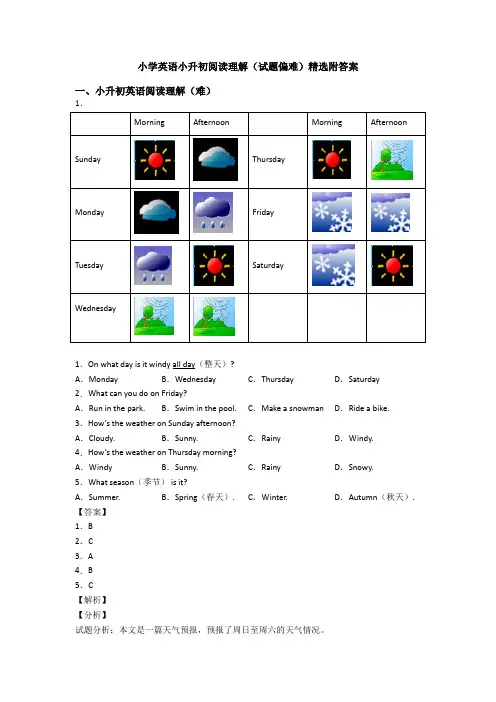
小学英语小升初阅读理解(试题偏难)精选附答案一、小升初英语阅读理解(难)1.Morning Afternoon Morning Afternoon Sunday ThursdayMonday FridayTuesday SaturdayWednesday1.On what day is it windy all day(整天)?A.Monday B.Wednesday C.Thursday D.Saturday 2.What can you do on Friday?A.Run in the park. B.Swim in the pool. C.Make a snowman D.Ride a bike. 3.How’s the weather on Sunday afternoon?A.Cloudy. B.Sunny. C.Rainy D.Windy. 4.How’s the weather on Thursday morning?A.Windy B.Sunny. C.Rainy D.Snowy. 5.What season(季节) is it?A.Summer. B.Spring(春天). C.Winter. D.Autumn(秋天).【答案】1.B2.C3.A4.B5.C【解析】【分析】试题分析:本文是一篇天气预报,预报了周日至周六的天气情况。
1.题意:哪一天刮一天风?考查细节理解题。
根据最后一栏Wednesday的图片信息,可知周三早上和下午都有风,故选B。
2.题意:星期五你能做什么?考查细节理解题。
A. Run in the park. 在公园里跑步;B. Swim in the pool. 在游泳池游泳;C. Make a snowman堆雪人;D. Ride a bike.骑车。
根据Friday一栏的图片信息,可知早上和下午都有雪,故选C。
3.题意:星期日下午的天气怎么样?考查细节理解题。
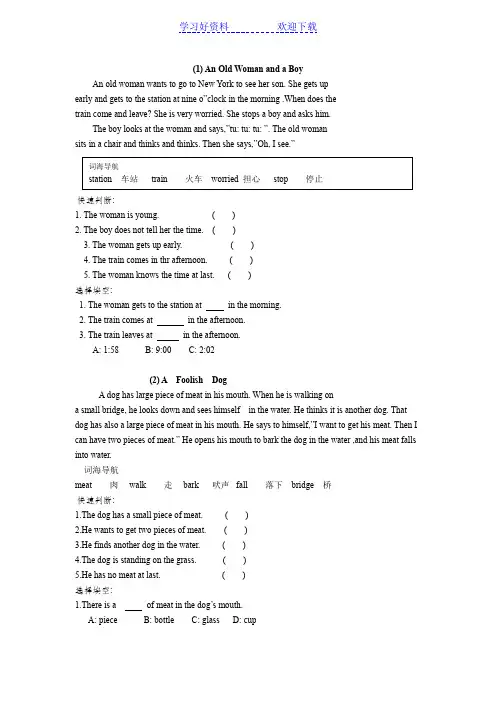
(1) An Old Woman and a BoyAn old woman wants to go to New York to see her son. She gets upearly and gets to the station at nine o”clock in the morning .When does thetrain come and leave? She is very worried. She stops a boy and asks him.The b oy looks at the woman and says,”tu: tu: tu: ”. The old womansits in a chair and thinks and thinks. Then she says,”Oh, I see.”词海导航station 车站train 火车worried 担心stop 停止快速判断:1. The woman is young. ( )2. The boy does not tell her the time. ( )3. The woman gets up early. ( )4. The train comes in thr afternoon. ( )5. The woman knows the time at last. ( )选择填空:1. The woman gets to the station at in the morning.2. The train comes at in the afternoon.3. The train leaves at in the afternoon.A: 1:58 B: 9:00 C: 2:02(2) A Foolish DogA dog has large piece of meat in his mouth. When he is walking ona small bridge, he looks down and sees himself in the water. He thinks it is another dog. That dog has also a large piece of meat in his mouth. He says to himself,”I want to get his meat. Then I can have two pieces of meat.” He opens his mouth to bark the dog in the water ,and his meat falls into water.词海导航meat 肉 walk 走 bark 吠声 fall 落下 bridge 桥快速判断:1.The dog has a small piece of meat. ( )2.He wants to get two pieces of meat. ( )3.He finds another dog in the water. ( )4.The dog is standing on the grass. ( )5.He has no meat at last. ( )选择填空:1.There is a of meat in the dog’s mouth.A: piece B: bottle C: glass D: cup2.The dog looks down and sees in the water.A: yourself B: myself C: himself D:herself3.He opens his mouth to .A: laugh B:cry C:eat D:dark(4) The Tiger’s DinnerTiger: Good afternoon. Mrs Goat. Let me eat you.Goat: Don’t eat me, Mr Tiger. I’m old. That deer is younger than me.(The goat runs away.)Tiger: Miss Deer, Miss Deer, Let me eat you.Deer: Oh, no. Many birds are standing over there. (The deer runs away.)Tiger: Birds, I will eat you. You are my dinner.Birds: (The birds fly away.) You are bad. We can fly, can you?Tiger: No, I can’t . But where is my dinner?选择填空:1. The tiger is . A: full B: hungry C: scared2.The tiger doesn’t eat the goat, because there is a over there.A: deer B: bird C: rabbit3.Can the bird fly? A: No, they can B: Yes ,they can. C: No, they can’t.4.The tiger can’t fly. He at last.A: eat dinner B: eat the goat C: doesn’t have dinner(5) Your Head Isn’t the Right SizeThe assistant: Can I help you, sir?A man: Yes, I would liked to buy a hat, please.The assistant: Of course. How about this one?A man: This one is too big. Would you mind bringing me a few more hats, please? The assistant: Not at all.A man: Let me try this one. No, I’m afraid it’s too wide. What about that one? No, I’mafraid it is wide enough. None of the hats is the right size.The assistant: The hats are all right, sir. But I’m afraid your head isn’t the right size.选择填空:1. The man wants to buy a .A: hat B: coat C: a pair of shoes2. The shop has hats. A: one B: two C: many3. brings him some hats, but none of them is fit.A: The assistant B: The doctor C: The customer4. The assistant says to the man ““.A: The hats aren’t the right size.B: Your head isn’t the size.C: We have no hat.(6) How many letters?Father: How many letters are there in the English Alphabet?Son: I don’t know.Father: You don’t know? You are in the school for one year and you don’t know how many letters there are in the Alphabet?Son: No. But let me ask you a question, Dad. You often go to the post office,please tell me how many letters there are in the post office?快速判断:1. There are twenty-six letters in the English Alphabet. ( )2. The son doesn’t study English well.( )3. The son can’t answer his father’s question.( )4. The father works in the post office. ( )5. There are twenty-six letters in the post office. ( )(7) Tom, Sam, Jim and JackTom, Sam, Jim and Jack live in a building of four floors. They live on different floors. They have different jobs—an engineer, a worker, a teacher and a doctor. Tom lives above Sam, but blow Jim. Jack lives on the third floor. The doctor lives above the teacher, but below the worker. The engineer lives on the ground floor. What are their jobs? Which floor does each of them live on? 回答问题:1. What does Sam do ?2. Which floor does Jim live on?3. What does Jack do ?4.Which floor does Tom live on?PEP小学英语六年级上学期阅读理解题专项训练At the Barber’sLen was thirty years old, and he had very long hair. He lived in a big city. Becaus e of his long hair, he did not find any work. One day he met an old friend, and this ma n said to him, “People in this city don’t like long hair. Why don’t you go to a barber? He can cut a lot of it off, and then you can get some work” At the barber’s Len said to the barber, “Please cut most of my hair off.”The barber began. He cut and cut for a long time and then he said to Len, “Were you i n the army a few years ago?”“Yes, I was,” Len answered, “Why did you ask that?”“Because I found a cap in your hair.”快速判断:1. Len was old, so he did not find any work.2. Len often wash his long hair.3. Len’s hair was short.4. Len barber found a cap in Len’s hair.5. Len was in the army now.选择填空:1.Len met one day.A: his father B: an old man C; his old friend2.Len was very .A: dirty B: clean C: tidy3. The cap was in Len’s.A: hand B: bag C: hair4. People in the city don’t like.A: straight hair B: long hair C: short hairBuying TicketsSam is a little boy, and he is only eight years old. One day he goes to the cinema. It is the first time for him to do that. He buys a ticket and then goes in. But after two or three minutes he comes out, buys a second ticket and goes in again. After a few minu tes he comes out again and buys a third ticket .Two or three minutes later he asks for an other ticket. Then the girl in the ticket office asks him, ”Why do you buy so many ticket s? How many friends do you meet?” Sam answers, ”No, I nave no friend here. But a big boy always stops me at the door and tears my tickets in piece.”快速判断:1. Sam buys the tickets for himself.2. Sam doesn’t go to the cinema.3. Sam is too young to make friends.4. Sam has no friend in the cinema.选择填空:1.Sam wants to buy when the girl asks him.A: the second ticket B: the third ticketC: the fourth ticket D: the fifth ticket2.The big boy stops Sam at the door because .A: it is the big boy’s job B: the big boy doesn’t like SamC: the big boy doesn’t know Sam D: Sam doesn’t buy tickets3. The big boy is of the cinema at all.A: a bookseller B: a policemanC: a shop keeper D: a worker4.From the story we know .A: the little boy has a lot of moneyB: the little boy knows nothing about the cinemaC: Sam doesn’t like the filmD: the girl wants to get more moneyAn Open-book ExamMiss Wang: Boys and girls, we’ll have an open-book exam. You can bring anything.Billy: Great!Miss Wang: Why are you so happy?Billy: Because I can bring my father.快速判断:1. The student will have an exam. ( )2. Billy is a good student. ( )3. Billy wants to bring his father. ( )4. The teacher does not let her students bring their books. ( )Where Is My Cat?Mr Black likes fish very much. He often buys some fish in the shop and takes them ho me for supper. His wife, Mrs Black often asks her friends to their home to have lunch a nd eat fish.One day, when Mr Black comes home in the evening, he cannot find his fish. And Mrs Black says their cat has eaten the fish. Mr Black is very angry. HE takes the cat to the shop near their house to weigh the cat. HE says,” You see, my fish is one kil o, and this cat is one kilo, too. My fish is here. Then where is my cat?”快速判断:1. Mr Black likes to eat cat very much. ( )2. Mrs Black often eats fish with her friend. ( )3. The cat is one kilo. ( )4. The cat ate the fish. ( )回答问题:1. What does Mr Black often do?2. How does Mr Black feel when he cannot find his fish?3. Who eats the fish?Don’t Cry, Miss WhiteMiss White is a teacher .Her home is not far from her school. SO she always walks to s chool in the morning everyday.One morning it is very cold and windy. Miss White walks to school. The cold wind goes into her eyes, and big tears begin running out her eyes. She gets to the school, opens th e door and goes to the classroom. It is warm there and Miss White is very happy. But th en a small boy looks at her for a few minutes, puts his arms round her and says kinds,”Don’t cry, Miss White. School isn’t very bad.’选择填空:1. Miss White usually goes to school .A: on cold morning B: on warm daysC: on windy morning D: on foot2. The small boy thinks that .A: Miss White doesn’t like the school.B: Miss White likes cry.C: Miss White’s eyes are not g ood.D: He does something wrong with his teacher.3. Which of the four is wrong?A: Miss White’s eyes are full of tears.B: The small boy knows why Jones is crying.C: The small boy loves his teacher.D: Miss White doesn’t cry at all.4. It is that morning. A: very cold outside B: windy outsideC: very warm in the classroom D: A, B and CThe Tiger’s DinnerTiger: Good afternoon. Mrs Goat. Let me eat you.Goat: Don’t eat me, Mr Tiger. I’m old. That deer is younger than me.(The goat runs away.)Tiger: Miss Deer, Miss Deer, Let me eat you.Deer: Oh, no. Many birds are standing over there. (The deer runs away.)Tiger: Birds, I will eat you. You are my dinner.Birds: (The birds fly away.) You are bad. We can fly, can you?Tiger: No, I can’t . But where is my dinner?选择填空:1. The tiger is .A: full B: hungry C: scared2.The tiger doesn’t eat the goat, because there is a over there.A: deer B: bird C: rabbit3.Can the bird fly?A: No, they can B: Yes ,th ey can. C: No, they can’t.4.The tiger can’t fly. He at last.A: eat dinner B: eat the goat C: doesn’t have dinnerThe Dog’s Dirty FeetIt’s a rainy day. A woman with a dog gets on a bus. It’s a big dog and its feet are not clean.The condu ctor doesn’t want the dog to sit on the chair. But the woman says to the cond uctor,” Oh, I pay for my dog. Can he sit here like the other people?” The conductor look s at the dog and says, ”Yes, Madam ,but like the other people, he must not put his feet on the chair.”选择填空:1. It’s a day. A: sunny B; fine C: rainy D: cloudy2. A woman with a dog gets on the bus.A: big B: small C: short D: thin3. The dog wants to sit on the .A: floor B: chair C: desk D: table4. The woman pays for her in the bus.A: friend B: cat C: dog D: sonLast Tuesday was my grandpa’s birthday. My family went to see him. My grandpa lives in a small town near our city. We went there by bus. This small town is a beautiful place. In the town, there is a long river. There are many flowers and fruit trees near the river. The air in the town is cleaner than in our city.My grandpa was born in 1945. He is very strong . He cooked much for us . There were beef, chicken, fish and vegetables. They were delicious. After meal, we had cakes and fruits. ( ) 1、My parents didn’t go to see my grandpa.( ) 2、The small town is near our city.( ) 3、There is a long river in my grandpa’s town.( ) 4、My grandpa is fifty.( ) 5、W e didn’t eat meat.Mike comes from Canada. His father Mr. Brown works in a hospital. Mrs. Brown is an English teacher. They all work in China. Mike has a sister. Her name is Kate.It’s Saturday today. Mr. Brown is reading in the room. Mrs. Brown is cooki ng. What is Mike doing? Oh, he is cleaning his new bike. Where is Kate? She is in her room. She is playing with her cat.( ) 1、Mike’s sister is Kate.( ) 2、Mike has a new car.( ) 3、Mr. and Mrs. Brown come from China.( ) 4、Mrs. Brown is cooking and cleaning.( ) 5、Kate is playing in her room.Five years ago Mr. Ma was a farmer. Now he lives in a city and works in a factory. He likes his jobs and he is happy to see many beautiful cars come out of the factory every day. He wants to buy a car this year. Then he can go to work by car and will not have to walk a long way every day. ( ) 1、Mr. Ma lives in the city three years ago.( ) 2、Mr. Ma is a worker now.( ) 3、Mr. Ma doesn’t have a car now.( ) 4、Mr. Ma goes to the factory by car every day now.( ) 5、Mr. Ma’s home is not near to the factory.Linling is a good girl. She is in Class Two, Grade Six. There are twenty girls and twenty boys in her class. She has a best friend, Mei Lan. She isn’t as tall as Mei Lan, but she is as old as Mei Lan. They like play computer games, and they study hard(刻苦). They often read in the school library after school.( ) 1. Linling is a good student.( ) 2. There are twenty students in her class.( ) 3. Meilan is older than Linling.( ) 4. They are good at computer games.( ) 5. There is a library in Meilan’s school.John is an English boy. He is studying in a primary school of China. There is a Sports Day in John’s school every autumn. This is his first Sports Day in China. John’s favourite sport is football. But he likes basketball, too. He is in the football team, Tom and Tony are John’s good friends. Look! Tom is running in the race. Tony is doing the high jump. John is playing football.( ) 1. The Sports Day is in autumn every year.( ) 2. John likes football and basketball.( ) 3. John is in the basketball team today.( ) 4. Tom is a good friend of John’s.( ) 5. Tony is jumping.My name is Betty. I’m a student. I go to school from Monday to Friday. My parents are teachers. They go to work from Monday to Friday. My grandparents are hard--working people. They cook and clean the house at home. So our house is very clean. We are all busy, but we are happy. Now I’m taller than last year. And I have a cousin. He is as old as I . We often play and go to school together.( ) 1. There are four people in the family.( ) 2. The people in the family are busy, but they are happy.( ) 3. Betty doesn’t go to school on Sunday.( ) 4. Betty and her cousin are in the same school, I think.( ) 5. Betty’s grandparents are teachers.Nex t Sunday is Liu Mei’s birthday. Many of her friends are going to go to her house. They are going to buy presents for Liu Mei. Ann says: “I’m going to buy a toy panda.” Betty says: “ I’m going to buy a very interesting book for her.” Zhang Ling and Wang Hui say:“ We’re going to buy a beautiful hat for her.”…At that time, they must say to Liu Mei: “Happy birthday”.( ) 1. Liu Mei’s birthday is on Sunday.( ) 2. Many friends are going to be at her birthday party.( ) 3. Betty is going to give a toy panda to Ann.( ) 4. Zhang Ling and Wang Hui are going to buy a beautiful hat for Betty.( ) 5. They’re going to say:” “Happy New Year” to you, Liu Mei!Hi, I am Jane. I want to tell you about my weekend plan. I am going to have a wonderful weekend. On Saturday, I am going the bookstore by bus. I am going to buy 2 new VCDs and some magazines. Then I am going to the cinema with my aunt. We are going in the morning. Then ,in the afternoon, I am going to do homework. And I am going to visit my grandparents with my brother. We are going to watch TV together. That will be fun. What about you?( )1. I am going to the bookstore by bike.( )2. I am going to buy new VCDs and magazines on Saturday.( )3.My friend and I are going to the cinema.( )4.We are going to visit my grandparents in the morning.( )5.I am going to do homework in the evening.Mr Green: Good morning, Mr Wu! How do you usually go to work?Mr Wu: I usually go to work by bike. But sometimes I go on foot. Ilike walking.Mr Green: Walking is good. Look at the sun. It’s a fine day for walking today.Mr Wu: That’s right. And the air today is nice and clean. What about you?Do you often go to work by bike?Mr Green: Yes, but not today.Mr Wu: Why not?Mr Green: My bike is broken.1.Mr Wu usually comes to school ____________. Sometimes he comes to school_______________ because he likes____________________.2.Mr Green often comes to school ___________. But today he comes to school________________.The weather is _____________ today.二、阅读故事,并根据故事的内容回答下列问题。
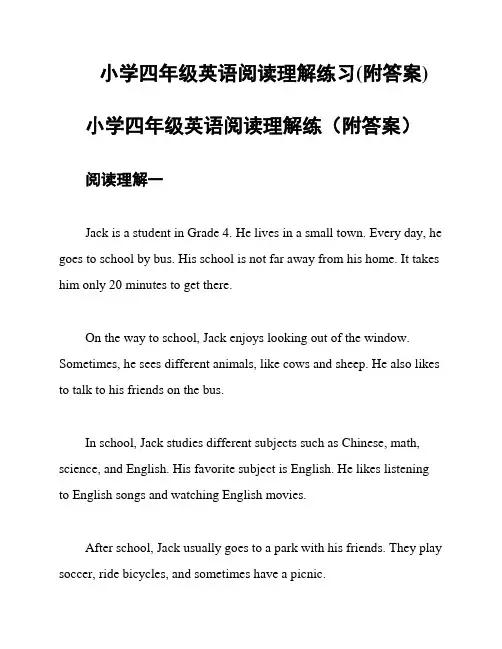
小学四年级英语阅读理解练习(附答案)小学四年级英语阅读理解练(附答案)阅读理解一Jack is a student in Grade 4. He lives in a small town. Every day, he goes to school by bus. His school is not far away from his home. It takes him only 20 minutes to get there.On the way to school, Jack enjoys looking out of the window. Sometimes, he sees different animals, like cows and sheep. He also likes to talk to his friends on the bus.In school, Jack studies different subjects such as Chinese, math, science, and English. His favorite subject is English. He likes listening to English songs and watching English movies.After school, Jack usually goes to a park with his friends. They play soccer, ride bicycles, and sometimes have a picnic.Questions1. How does Jack go to school?2. How long does it take for Jack to get to school?3. What animals does Jack sometimes see on his way to school?4. What is Jack's favorite subject in school?5. Where does Jack go after school?Answers1. Jack goes to school by bus.2. It takes Jack 20 minutes to get to school.3. Jack sometimes sees cows and sheep on his way to school.4. Jack's favorite subject in school is English.5. Jack goes to a park with his friends after school.阅读理解二Lucy is a girl in Grade 4. She lives in a big city. Every day, her mom drives her to school. It usually takes them 30 minutes to reach school as there is more traffic in the city.During the drive, Lucy likes talking to her mom. They usually discuss their plans for the day and talk about their favorite food.In school, Lucy enjoys learning different subjects. She is good at mathematics and science. Her favorite activity is the science experiments conducted in class.After school, Lucy attends an art class where she learns to paint and draw. She also enjoys visiting the nearby library to borrow books.Questions1. How does Lucy go to school?2. How long does it take for Lucy and her mom to reach school?3. What do Lucy and her mom usually talk about during the drive?4. What is Lucy's favorite subject in school?5. What activities does Lucy do after school?Answers1. Lucy goes to school by car.2. It takes Lucy and her mom 30 minutes to reach school.3. Lucy and her mom usually talk about their plans for the day and their favorite food during the drive.4. Lucy's favorite subject in school is science.5. After school, Lucy attends an art class and visits the nearby library to borrow books.。
(1) An Old Woman and a BoyAn old woman wants to go to New York to see her son. She gets upearly and gets to the station at nine o”clock in the morning .When does thetrain come and leave? She is very worried. She stops a boy and asks him.The b oy looks at the woman and says,”tu: tu: tu: ”. The old womansits in a chair and thinks and thinks. Then she says,”Oh, I see.”快速判断:1. The woman is young. ( )2. The boy does not tell her the time. ( )3. The woman gets up early. ( )4. The train comes in thr afternoon. ( )5. The woman knows the time at last. ( )选择填空:1. The woman gets to the station at in the morning.2. The train comes at in the afternoon.3. The train leaves at in the afternoon.A: 1:58 B: 9:00 C: 2:02(2) A Foolish DogA dog has large piece of meat in his mouth. When he is walking ona small bridge, he looks down and sees himself in the water. He thinks it is another dog. That dog has also a large piece of meat in his mouth. He says to himself,”I want to get his meat. Then I can have two pieces of meat.” He opens his mouth to bark the dog in the water ,and his meat falls into water.词海导航meat 肉 walk 走 bark 吠声 fall 落下 bridge 桥快速判断:1.The dog has a small piece of meat. ( )2.He wants to get two pieces of meat. ( )3.He finds another dog in the water. ( )4.The dog is standing on the grass. ( )5.He has no meat at last. ( )选择填空:1.There is a of meat in the dog’s mouth.A: piece B: bottle C: glassD: cup2.The dog looks down and sees in the water.A: yourself B: myself C: himself D:herself3.He opens his mouth to .A: laugh B:cry C:eat D:dark(4) The Tiger’s DinnerTiger: Good afternoon. Mrs Goat. Let me eat you.Goat: Don’t eat me, Mr Tiger. I’m old. That deer is younger than me.(The goat runs away.)Tiger: Miss Deer, Miss Deer, Let me eat you.Deer: Oh, no. Many birds are standing over there. (The deer runs away.)Tiger: Birds, I will eat you. You are my dinner.Birds: (The birds fly away.) You are bad. We can fly, can you?Tiger: No, I can’t . But where is my dinner?选择填空:1. The tiger is . A: full B: hungry C: scared2.The tiger doesn’t eat the goat, because there is a over there.A: deer B: bird C: rabbit3.Can the bird fly? A: No, they can B: Yes ,they can. C: No, they can’t.4.The tiger can’t fly. He at last.A: eat dinner B: eat the goat C: doesn’t have dinner(5) Your Head Isn’t the Right SizeThe assistant: Can I help you, sir?A man: Yes, I would liked to buy a hat, please.The assistant: Of course. How about this one?A man: This one is too big. Would you mind bringing me a few more hats, please? The assistant: Not at all.A man: Let me try this one. No, I’m afraid it’s too wide. What about that one? No, I’mafraid it is wide enough. None of the hats is the right size.The assistant: The hats are all right, sir. But I’m afraid your head isn’t the right size.选择填空:1. The man wants to buy a .A: hat B: coat C: a pair of shoes2. The shop has hats. A: one B: two C: many3. brings him some hats, but none of them is fit.A: The assistant B: The doctor C: The customer4. The assistant says to the man ““.A: The hats aren’t the right size.B: Your head isn’t the size.C: We have no hat.(6) How many letters?Father: How many letters are there in the English Alphabet?Son: I don’t know.Father: You don’t know? You are in the school for one year and you don’t know how many letters there are in the Alphabet?Son: No. But let me ask you a question, Dad. You often go to the post office,please tell me how many letters there are in the post office?快速判断:1. There are twenty-six letters in the English Alphabet. ( )2. The son doesn’t study English well.( )3. The son can’t answer his father’s question.( )4. The father works in the post office. ( )5. There are twenty-six letters in the post office. ( )(7) Tom, Sam, Jim and JackTom, Sam, Jim and Jack live in a building of four floors. They live on different floors. They have different jobs—an engineer, a worker, a teacher and a doctor. Tom lives above Sam, but blow Jim. Jack lives on the third floor. The doctor lives above the teacher, but below the worker. The engineer lives on the ground floor. What are their jobs? Which floor does each of them live on? 回答问题:1. What does Sam do ?2. Which floor does Jim live on?3. What does Jack do ?4.Which floor does Tom live on?PEP小学英语六年级上学期阅读理解题专项训练At the Barber’sLen was thirty years old, and he had very long hair. He lived in a big city. Becaus e of his long hair, he did not find any work. One day he met an old friend, and this ma n said to him, “People in this city don’t like long hair. Why don’t you go to a barber? He can cut a lot of it off, and then you can get some work” At the barber’s Len said to the barber, “Please cut most of my hair off.”The barber began. He cut and cut for a long time and then he said to Len, “Were you i n the army a few years ago?”“Yes, I was,” Len answered, “Why did you ask that?”“Because I found a cap in your hair.”快速判断:1. Len was old, so he did not find any work.2. Len often wash his long hair.3. Len’s hair was short.4. Len barber found a cap in Len’s hair.5. Len was in the army now.选择填空:1.Len met one day.A: his father B: an old man C; his old friend2.Len was very .A: dirty B: clean C: tidy3. The cap was in Len’s.A: hand B: bag C: hair4. People in the city don’t like.A: straight hair B: long hair C: short hairBuying TicketsSam is a little boy, and he is only eight years old. One day he goes to the cinema. It is the first time for him to do that. He buys a ticket and then goes in. But after two or three minutes he comes out, buys a second ticket and goes in again. After a few minu tes he comes out again and buys a third ticket .Two or three minutes later he asks for an other ticket. Then the girl in the ticket office asks him, ”Why do you buy so many ticket s? How many friends do you meet?” Sam answers, ”No, I nave no friend here. But a big boy always stops me at the door and tears my tickets in piece.”快速判断:1. Sam buys the tickets for himself.2. Sam doesn’t go to the cinema.3. Sam is too young to make friends.4. Sam has no friend in the cinema.选择填空:1.Sam wants to buy when the girl asks him.A: the second ticket B: the third ticketC: the fourth ticket D: the fifth ticket2.The big boy stops Sam at the door because .A: it is the big boy’s job B: the big boy doesn’t like SamC: the big boy doesn’t know Sam D: Sam doesn’t buy tickets3. The big boy is of the cinema at all.A: a bookseller B: a policemanC: a shop keeper D: a worker4.From the story we know .A: the little boy has a lot of moneyB: the little boy knows nothing about the cinemaC: Sam doesn’t like the filmD: the girl wants to get more moneyAn Open-book ExamMiss Wang: Boys and girls, we’ll have an open-book exam. You can bring anything.Billy: Great!Miss Wang: Why are you so happy?Billy: Because I can bring my father.快速判断:1. The student will have an exam. ( )2. Billy is a good student. ( )3. Billy wants to bring his father. ( )4. The teacher does not let her students bring their books. ( )Where Is My Cat?Mr Black likes fish very much. He often buys some fish in the shop and takes them ho me for supper. His wife, Mrs Black often asks her friends to their home to have lunch a nd eat fish.One day, when Mr Black comes home in the evening, he cannot find his fish. And Mrs Black says their cat has eaten the fish. Mr Black is very angry. HE takes the cat to the shop near their house to weigh the cat. HE says,” You see, my fish is one kil o, and this cat is one kilo, too. My fish is here. Then where is my cat?”快速判断:1. Mr Black likes to eat cat very much. ( )2. Mrs Black often eats fish with her friend. ( )3. The cat is one kilo. ( )4. The cat ate the fish. ( )回答问题:1. What does Mr Black often do?2. How does Mr Black feel when he cannot find his fish?3. Who eats the fish?Don’t Cry, Miss WhiteMiss White is a teacher .Her home is not far from her school. SO she always walks to s chool in the morning everyday.One morning it is very cold and windy. Miss White walks to school. The cold wind goes into her eyes, and big tears begin running out her eyes. She gets to the school, opens th e door and goes to the classroom. It is warm there and Miss White is very happy. But th en a small boy looks at her for a few minutes, puts his arms round her and says kinds,”Don’t cry, Miss White. School isn’t very bad.’选择填空:1. Miss White usually goes to school .A: on cold morning B: on warm daysC: on windy morning D: on foot2. The small boy thinks that .A: Miss White doesn’t like the school.B: Miss White likes cry.C: Miss White’s eyes are not g ood.D: He does something wrong with his teacher.3. Which of the four is wrong?A: Miss White’s eyes are full of tears.B: The small boy knows why Jones is crying.C: The small boy loves his teacher.D: Miss White doesn’t cry at all.4. It is that morning. A: very cold outside B: windy outsideC: very warm in the classroom D: A, B and CThe Tiger’s DinnerTiger: Good afternoon. Mrs Goat. Let me eat you.Goat: Don’t eat me, Mr Tiger. I’m old. That deer is younger than me.(The goat runs away.)Tiger: Miss Deer, Miss Deer, Let me eat you.Deer: Oh, no. Many birds are standing over there. (The deer runs away.)Tiger: Birds, I will eat you. You are my dinner.Birds: (The birds fly away.) You are bad. We can fly, can you?Tiger: No, I can’t . But where is my dinner?选择填空:1. The tiger is .A: full B: hungry C: scared2.The tiger doesn’t eat the goat, because there is a over there.A: deer B: bird C: rabbit3.Can the bird fly?A: No, they can B: Yes ,th ey can. C: No, they can’t.4.The tiger can’t fly. He at last.A: eat dinner B: eat the goat C: doesn’t have dinnerThe Dog’s Dirty FeetIt’s a rainy day. A woman with a dog gets on a bus. It’s a big dog and its feet are not clean.The condu ctor doesn’t want the dog to sit on the chair. But the woman says to the cond uctor,” Oh, I pay for my dog. Can he sit here like the other people?” The conductor look s at the dog and says, ”Yes, Madam ,but like the other people, he must not put his feet on the chair.”选择填空:1. It’s a day. A: sunny B; fine C: rainy D: cloudy2. A woman with a dog gets on the bus.A: big B: small C: short D: thin3. The dog wants to sit on the .A: floor B: chair C: desk D: table4. The woman pays for her in the bus.A: friend B: cat C: dog D: sonLast Tuesday was my grandpa’s birthday. My family went to see him. My grandpa lives in a small town near our city. We went there by bus. This small town is a beautiful place. In the town, there is a long river. There are many flowers and fruit trees near the river. The air in the town is cleaner than in our city.My grandpa was born in 1945. He is very strong . He cooked much for us . There were beef, chicken, fish and vegetables. They were delicious. After meal, we had cakes and fruits. ( ) 1、My parents didn’t go to see my grandpa.( ) 2、The small town is near our city.( ) 3、There is a long river in my grandpa’s town.( ) 4、My grandpa is fifty.( ) 5、W e didn’t eat meat.Mike comes from Canada. His father Mr. Brown works in a hospital. Mrs. Brown is an English teacher. They all work in China. Mike has a sister. Her name is Kate.It’s Saturday today. Mr. Brown is reading in the room. Mrs. Brown is cooki ng. What is Mike doing? Oh, he is cleaning his new bike. Where is Kate? She is in her room. She is playing with her cat.( ) 1、Mike’s sister is Kate.( ) 2、Mike has a new car.( ) 3、Mr. and Mrs. Brown come from China.( ) 4、Mrs. Brown is cooking and cleaning.( ) 5、Kate is playing in her room.Five years ago Mr. Ma was a farmer. Now he lives in a city and works in a factory. He likes his jobs and he is happy to see many beautiful cars come out of the factory every day. He wants to buy a car this year. Then he can go to work by car and will not have to walk a long way every day. ( ) 1、Mr. Ma lives in the city three years ago.( ) 2、Mr. Ma is a worker now.( ) 3、Mr. Ma doesn’t have a car now.( ) 4、Mr. Ma goes to the factory by car every day now.( ) 5、Mr. Ma’s home is not near to the factory.Linling is a good girl. She is in Class Two, Grade Six. There are twenty girls and twenty boys in her class. She has a best friend, Mei Lan. She isn’t as tall as Mei Lan, but she is as old as Mei Lan. They like play computer games, and they study hard(刻苦). They often read in the school library after school.( ) 1. Linling is a good student.( ) 2. There are twenty students in her class.( ) 3. Meilan is older than Linling.( ) 4. They are good at computer games.( ) 5. There is a library in Meilan’s school.John is an English boy. He is studying in a primary school of China. There is a Sports Day in John’s school every autumn. This is his first Sports Day in China. John’s favourite sport is football. But he likes basketball, too. He is in the football team, Tom and Tony are John’s good friends. Look! Tom is running in the race. Tony is doing the high jump. John is playing football.( ) 1. The Sports Day is in autumn every year.( ) 2. John likes football and basketball.( ) 3. John is in the basketball team today.( ) 4. Tom is a good friend of John’s.( ) 5. Tony is jumping.My name is Betty. I’m a student. I go to school from Monday to Friday. My parents are teachers. They go to work from Monday to Friday. My grandparents are hard--working people. They cook and clean the house at home. So our house is very clean. We are all busy, but we are happy. Now I’m taller than last year. And I have a cousin. He is as old as I . We often play and go to school together.( ) 1. There are four people in the family.( ) 2. The people in the family are busy, but they are happy.( ) 3. Betty doesn’t go to school on Sunday.( ) 4. Betty and her cousin are in the same school, I think.( ) 5. Betty’s grandparents are teachers.Nex t Sunday is Liu Mei’s birthday. Many of her friends are going to go to her house. They are going to buy presents for Liu Mei. Ann says: “I’m going to buy a toy panda.” Betty says: “ I’m going to buy a very interesting book for her.” Zhang Ling and Wang Hui say:“ We’re going to buy a beautiful hat for her.”…At that time, they must say to Liu Mei: “Happy birthday”.( ) 1. Liu Mei’s birthday is on Sunday.( ) 2. Many friends are going to be at her birthday party.( ) 3. Betty is going to give a toy panda to Ann.( ) 4. Zhang Ling and Wang Hui are going to buy a beautiful hat for Betty.( ) 5. They’re going to say:” “Happy New Year” to you, Liu Mei!Hi, I am Jane. I want to tell you about my weekend plan. I am going to have a wonderful weekend. On Saturday, I am going the bookstore by bus. I am going to buy 2 new VCDs and some magazines. Then I am going to the cinema with my aunt. We are going in the morning. Then ,in the afternoon, I am going to do homework. And I am going to visit my grandparents with my brother. We are going to watch TV together. That will be fun. What about you?( )1. I am going to the bookstore by bike.( )2. I am going to buy new VCDs and magazines on Saturday.( )3.My friend and I are going to the cinema.( )4.We are going to visit my grandparents in the morning.( )5.I am going to do homework in the evening.Mr Green: Good morning, Mr Wu! How do you usually go to work?Mr Wu: I usually go to work by bike. But sometimes I go on foot. Ilike walking.Mr Green: Walking is good. Look at the sun. It’s a fine day for walking today.Mr Wu: That’s right. And the air today is nice and clean. What about you?Do you often go to work by bike?Mr Green: Yes, but not today.Mr Wu: Why not?Mr Green: My bike is broken.1.Mr Wu usually comes to school ____________. Sometimes he comes to school_______________ because he likes____________________.2.Mr Green often comes to school ___________. But today he comes to school________________.The weather is _____________ today.二、阅读故事,并根据故事的内容回答下列问题。
一、英语阅读理解训练1.阅读理解阅读短文,判断对错One day Mr Li and Mr Wang went to London to see a friend. They didn't know much English and they knew little about London. They didn't find their friend's home. They walked in the street for a long time. Then they saw a man near a shop. They went up to him and asked the way. The man smiled but said nothing(什么都没说) . Then he put his hand into his pocket and took out a book and read, "I'm sorry, I can't speak English." At last they found their friend's home with the help of a policeman.(1)Mr. Li and Mr. Wang knew much about London.(2)They spoke English very well.(3)The man near the shop helped them find their friend's home.(4)They didn't see any policeman in London.(5)The man near the shod couldn't speak English.【答案】(1)0(2)0(3)0(4)0(5)1【考点】阅读理解【解析】【分析】大意:短文讲述了李先生和王先生去伦敦看朋友,他们不太懂英语,对伦敦也不太了解,最后,他们在警察的帮助下找到了朋友的家。
小学英语毕业考总复习——阅读理解一,根据短文内容判断正误,对的写“T”,错的写“F”。
(30分)(A)My name is ChenJie. I have a new pen pal, her name is Rose. She is 13 years old. She is one year older than me. She lives in Canada with her family. Her father is a doctor. He works in a big hospital. He goes to work by car. Her mother is a policewoman. She likes helping people. She goes to work by motorcycle. Betty is Rose’s twin sister. They look the same, but they are very different. Betty likes playing the violin, Rose likes reading books. They usually play in the park on Sundays. I write an email to Rose every week. Rose says her family is going to China soon. I am very excited.( ) 1, ChenJie is one year younger than Betty.( ) 2, Rose’s father is a policeman.( ) 3, Rose’s mother likes helping people.( ) 4, Betty likes reading books.( ) 5, I write an email to Rose everyday.(B)Little David likes to eat in a restaurant. He often eats hamburgers and potato chips. Many people in the restaurant know him very well. They often ask him, “Why do you like to eat here?”Little David says “Because I like the toys here.”“Why don’t you go to the toy shop then?” Little David says, “ They have toys but they don’t have hamburgers and potato chips.”( ) 1, Little David doesn’t like the toys at all.( ) 2, A lot of people know the boy well in the restaurant.( ) 3, Little David likes to eat in the restaurant.( ) 4, People want to know why he often eats in the same restaurant.( ) 5, Little David doesn’t like hamburgers and potato chips.(C)Mr. Green looks out of his window. There is a boy in the street. He is eating a hamburger. There is a dog in the street, too. The boy says, “Come here, good dog. I’m going to give you some hamburgers. ” The dog comes up. The boy kicks the dog. The dog runs away.Mr. Green comes out of the house and says to the boy, “Come here, I’m going to give you some money.”The boy is happy and goes to Mr. Green. But Mr. Green doesn’t give him any money. He kicks the boy. The boy cries and says, “Why do you kick me? I don’t ask you for money. ”“The dog doesn’t ask you for any hamburgers.” Mr. Green says, “But you kick it.”( ) 1. The boy is having some bread in the street.( ) 2. The boy doesn’t give the dog any hamburgers.( ) 3. The boy likes the dog.( ) 4. Mr. Green wants to give the boy some money.( ) 5. Mr. Green is going to give the boy a lesson (教训).二,根据短文内容,选择正确的答案。
人教PEP版小学英语教学资料设计
人教PEP版小学英语教学资料设计
小学英语阅读解题技巧
阅读理解能力是一个学生英语语言能力的重要体现。小学英语阅读理解是小学英语的重要教
学目标,也是小学英语测试的重要组成部分。把握小学英语阅读理解的解题技巧,对于解题具有
重要的意义。
小学英语阅读理解的题型无外乎这么几种:
(1) 阅读短文,判断正误;
(2) 阅读短文,选择正确答案;
(3) 阅读短文,回答问题;
(4) 任务型阅读。
题型虽然较多,但是只要找到了阅读理解的技巧,解题并不困难。
例一:
阅读下列短文,并根据短文内容判断所给句子是否正确,正确的写“T”,错误的写“F”。
Mrs White has two children. John is seven. Ann is only three. John is a good brother. He is
always very nice to his sister. One day in the afternoon, Mrs White was cooking dinner in the
kitchen, and the two children were playing games in the garden. Suddenly, Ann began to cry and
she ran to her mum in the kitchen. Mrs White asked, “What’s wrong with you, Ann?” “John
broke(弄坏了)my toy bear,” Ann answered sadly. “How did he do it?” mum said. Ann stopped
crying, and thought for a few seconds, “I hit(打)his head with it.”
判断正误:
( ) 1. John isn’t a good brother to his sister.
( ) 2. Ann is four years younger than John.
( )3.The two children played some games, and their mother was busy at home .
( ) 4. John broke Ann’s toy bear.
( ) 5. “sadly” means very happy.
在解答这篇短文的题目中,实际上可以采用下列技巧:
1.排除干扰,抓住关键信息。
阅读理解,不能为枝节信息所左右,要看主要信息。以第1小题为例,尽管短文最后说到了
“John broke my toy bear.”,但是短文中的关键词是“always”,即“He is always very nice to his sister.”,
更不用说是Ann先打了John的头。因此,答案一定是F。
人教PEP版小学英语教学资料设计
人教PEP版小学英语教学资料设计
2.适当运算,推导正确答案。
阅读理解题中,有不少题只要通过正确的运算,就能得出正确答案。以第2小题为例,短文告诉
我们“John is seven. Ann is only three.”,因此,John就比Ann大4岁,显然题干“Ann is four years
younger than John.”与事实正好相符,答案自然是T。
3.依据事实,进行逆向思维。
阅读理解题中,有些题目似是而非,关键看我们怎么根据事实进行分析。以第3小题为例,“and
the two children were playing games in the garden”支持题干中的“The two children played some
games”。问题的关键是,John和Ann的母亲是否是“busy”。短文中“Mrs White was cooking dinner
in the kitchen”这句话总不能说Mrs White是在玩吧?因此,通过逆向思维,我们可以判断Mrs
White是busy的。答案就不言自明了。
4.根据语境,进行逻辑推断。
阅读理解题中,有些题目很难一眼看出正确答案,尤其是类似任务型阅读的题目,第5小题
便是如此。如何判断“sadly”的语义,关键要看我们能否根据语境进行逻辑推理。一个小女孩的
玩具被他人搞坏了,她总不能开心吧?因此,“Ann answered sadly.”中的“sadly”一词的意思不可能
是“开心的”,答案应为F。
当然,小学英语阅读理解的解题技巧远不止如此。我们将在以后的学习中继续加以讨论。